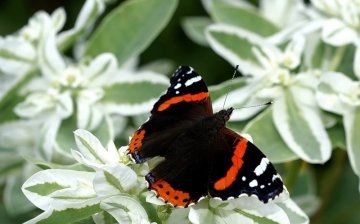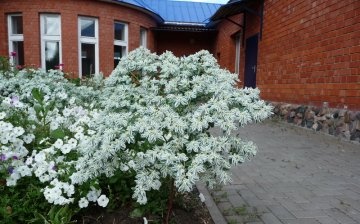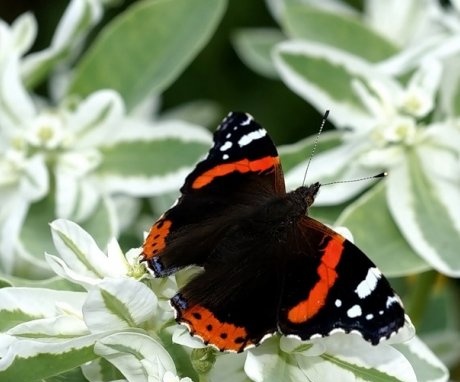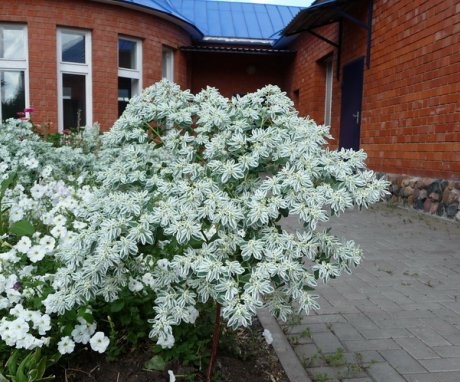The beauty of "mountain snow" or how to grow bordered euphorbia
How to make your garden cozy, original, bright and unlike everyone else? You can hire a designer, spending a lot of money, or you can choose and plant those plantsthat fit perfectly and emphasize the beauty of the land. For this you can use flowers, shrubs and, of course, green plants. One of the few and popular types of annuals is spurge Bordered is a powerful weapon in the hands of professional landscape designers.
Content:
Description of the plant
Bordered spurge is original annual garden plant, which has a long and thin stem with a height of 20 to 80 centimeters. The multiple leaves of milkweed are light green in color, oval in shape, with an average size of up to 5 centimeters. It blooms in very small, light colored flowers that have wide white appendages... During this period, they read to change their appearance and the leaves of the plant. They acquire a white cut, which does not wither and does not shrink until the autumn frosts. It is not for nothing that the conservative English called this species of milkweed "mountain snow".
Sowing milkweed bordered
This type of milkweed reproduces vegetative and by seed methods, which makes it easy for gardeners to find material for planting. But, each of the planting methods has its own characteristics. For example, you can plant edged euphorbia in the following ways:
- Sowing before winter
- Sowing in open ground
- Planting by cuttings
Sowing before winter is carried out by seeds in the month of February or at the beginning of March. The large grains are placed in a small container with a standard soil mixture for seedlings... They are stuck to a depth of 3-4 centimeters. The seed pot is placed on a warm windowsill. After 3 - 5 days, the first shoots appear.
As soon as full-fledged leaves grow into plants, seedlings dive, seating in separate cups.
When the threat of night frosts has passed, the spurge is planted in a flower bed at a distance of 20 - 30 centimeters from each other. The soil for their summer bloom should not be too oily or fertilized... Rocky or sandy substrates are ideal. Although in loose soil, the edged euphorbia will feel comfortable. The plant does not like an excess of useful minerals and top dressing.
It is also worth noting that when planting a flower, you should avoid too humid places with a high level of groundwater. Excess water can cause milkweed rhizome to rot.
The second planting method is open soil sowing, which is carried out in early May. The soil in the flowerbed is well dug, weeds are removed, small holes up to 7 centimeters deep are pulled out. Milkweed seed is sown into moistened soil. The first shoots appear only in the second week. For better growth, weaker seedlings are pulled out, making room for stronger representatives to grow.
The third method is planting by cuttings. To do this, you need to cut off a small twig from an adult plant. We lower it in warm water to stop the flow of milky juice, since it is he promotes rooting of the cutting... We place the container with water and the future flower in the shade at a temperature of +20 - 25 degrees Celsius and leave it for a day. Euphorbia should dry up. Then we plant the cutting in a sandy-peat mixture.Within 25 days, the new plant will take root, and only having noticed the growth of the cutting, you can freely plant it in the garden bed.
Culture care
Euphorbia bordered - the culture is extremely unpretentious and quite hardy. The flower tolerates heat well and blooms from July to the first frost, and sometimes even longer. Also spurge is not affected. pests and resistant to all kinds diseases... It does not need to be fertilized or sprayed often, it is enough just to follow some care rules:
- It is worth working with a flower only if you have protective equipment - gloves. Milkweed juice is very poisonous... It causes an allergic reaction, itching, redness and even burns;
- Remove weeds. They affect the thickness of the euphorbia stem;
- Do not plant crops near paved paths. The distance from the passage must be at least 30 cm;
- Planting a plant around the perimeter protects the rest of the flowers from dust. But at the same time, proximity to crops with a stronger root system should be avoided;
- It is forbidden to plant euphorbia bordered in the shade. The plant will not develop and will soon die;
- Euphorbia tolerates heat well, but in the absence of rain for a long time, it is worth it to water under the root;
- Watering the leaves is prohibited;
- During the flowering period, "mountain snow" can be fed manure solution... For 10 liters of water, 200 grams of manure is used. The solution is infused for 24 hours. Introduce only in the evening and at the root;
- At the beginning of September, the period begins ripening of seeds... They fall down and take root. If in the future it is planned to plant milkweed in the same place, it is worth loosen the soil a little and the seedlings will sprout up on their own next year;
- Plants are also planted in vegetable gardens in order to scare off moles and other rodents. Planting is carried out along the perimeter of the garden.
Video review of the types of milkweed:














What an unusual and unusual plant! I first learned about him from this article and immediately wanted to plant such beauty at home. Perhaps someday I will decide on this